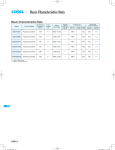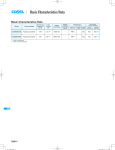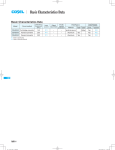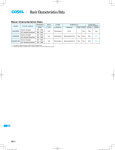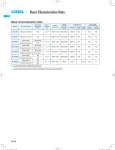Download Basic characteristics data • Instruction manual
Transcript
Basic Characteristics Data Basic Characteristics Data Model Circuit method Switching frequency [kHz] Rated input fuse Inrush current protection Material SNDPG750 Active filter 130 250V 12A SCR FR-4 SNDPG SNDPG-4 Series/Parallel operation availability PCB/Pattern Single sided Double sided Series operation Parallel operation Yes No No AC-DC Power Supplies Bus Converter . Power Module Value-added Type Instruction Manual 1 Terminal Connection SNDPG-6 2 Input Voltage Derating SNDPG-6 3 Standard Connection Method SNDPG-6 4 5 6 3.1 Standard connection method SNDPG-6 3.2 Connection of loaded circuit SNDPG-6 3.3 Heatsink SNDPG-6 Function SNDPG-7 4.1 Overcurrent protection SNDPG-7 4.2 Overvoltage protection SNDPG-7 4.3 Thermal protection SNDPG-7 4.4 Enable signal (ENA) SNDPG-7 4.5 Isolation SNDPG-7 Series and Parallel Operation SNDPG-7 5.1 Series operation SNDPG-7 5.2 Parallel operation SNDPG-7 Implementation-Mounting Method SNDPG-7 6.1 Mounting method SNDPG-7 6.2 Derating SNDPG-8 SNDPG 7 Optional and Others 7.1 Outline of option SNDPG-9 SNDPG-9 SNDPG-5 AC-DC Power Supplies Bus Converter . Power Module Value-added Type 1 Terminal Connection 8 7 1 2 3 CN2 CN1 Instruction Manual 2 Input Voltage Derating ¡Fig.2.1 shows rated output for each input voltage section. 5 6 Output power [W] 4 750 500 85 170 Input Voltage [AC V] Fig.2.1 Input voltage derating curve (SNDPG750) 3 Standard Connection Method Fig.1.1 Terminal connection (top view) 3.1 Standard connection method ¡To use SNDPG Series, connection shown in Fig.3.1. Through this connection, DC output voltage can be obtained from AC input voltage. Table 1.1 Terminal connection and functions Terminal connection No. Function AC input voltage and DC output voltage are not insulated. 1 FG 2 AC(N) 3 AC(L) 4 +VOUT +DC output 5 -VOUT -DC output 6 ENA Enable signal FG Heatsink AC Input SNDPG750 (L) +V +V -V -V AC IN (N) ENA 7 +RC Remote ON/OFF (+RC) Optional 8 -RC Remote ON/OFF (-RC) Optional Pin No. 1 2 3 4 ENA -V NC +V RC1(SNDHS series) ENA(SNDBS series) FG FG Fig.3.1 Standard connection method Table 1.2 Pin configuration and functions of CN1 SNDPG SNDHS series SNDBS series ¡Confirm each specification and instruction manual about the SNDHS/ Function : Enable signal : -DC OUTPUT (-VOUT) : No connection : +DC OUTPUT (+VOUT) SNDBS series. 3.2 Connection of loaded circuit Table 1.3 Pin configuration and functions of CN2 (optional) ¡For connecting the SNDHS series (SNDHS50B / 100B / 250B) and SNDBS series, see Fig.3.1. Pin No. 1 2 ¡Control load current so that it may flow only when the terminal ENA is at “H”. At “L” when inrush current protection circuit is not +RC -RC Function : Remote ON/OFF (+RC) : Remote ON/OFF(-RC) released, excessive current may be applied to the circuit. Table 1.4 Mating connectors and terminals of CN1 and CN2 Connector Mating connector CN1 B3P4-VH VHR-4N CN2 B2B-XH-AM XHP-2 Terminal Mfr. 3.3 Heatsink Chain:SVH-21T-P1.1 Loose:BVH-21T-P1.1 Chain:SXH-001T-P0.6 Loose:BXH-001T-P0.6 ¡For connection of loads except the SNDHS series and SNDBS series, please contact us. J.S.T. ¡The power supply adopts the conduction cooling system. Attach a heatsink to the aluminum base plate to cool the power supply for use. Refer to 6.2 Derating. SNDPG-6 AC-DC Power Supplies Bus Converter . Power Module Value-added Type Instruction Manual 4.5 Isolation 4 Function ¡For a receiving inspection, such as Hi-Pot test, gradually increase (decrease) the voltage for a start (shut down). Avoid using Hi-Pot tester with the timer because it may generate voltage a few times 4.1 Overcurrent protection higher than the applied voltage, at ON/OFF of a timer. ¡The overcurrent protection circuit is not built-in. 4.2 Overvoltage protection ¡The overvoltage protection circuit is built-in. The AC input should be shut down if overvoltage protection is in operation. When this function operates, the power factor corrector function 5 Series and Parallel Operation does not operate, and output voltage becomes the full-wave rectified AC input voltage. 5.1 Series operation Remarks: Please note that the unit’s internal components may be damaged ¡As input and output are not insulated, series operation is impossible. if excessive voltage (over rated voltage) is applied to output terminal of power supply. This could happen when the customer tests the overvoltage performance of the unit. 5.2 Parallel operation ¡Parallel operation is not possible. 4.3 Thermal protection ¡Thermal protection circuit is built-in and it operates about 115C. If this function comes into effect, shut down the output, eliminate all possible causes of overheating, and drop the temperature to normal level. To prevent the unit from overheating, avoid using the unit in a dusty, poorly ventilated environment. When this function operates, the power factor corrector function 6 ImplementationMounting Method does not operate, and output voltage becomes the full-wave rectified AC input voltage and ENA output changes into "L". 6.1 Mounting method ¡The unit can be mounted in any direction. When two or more power supplies are used side by side, position them with proper 4.4 Enable signal (ENA) ¡Use ENA to control starting of the loaded power supply. ¡When inrush current protection circuit is released, ENA outputs “Hight” . intervals to allow enough air ventilation. Aluminum base plate temperature (Point A) around each power supply should not exceed the temperature range shown in derating curve. ¡If load current flows without releasing of the circuit, the resistor may be burnt. ¡In case of metal chassis, keep the distance between d1 for to insulate between lead of component and metal chassis. If it is less than d1, insert the insulation sheet between power supply and No. 1 2 3 4 Table 4.1 Specification of ENA Item ENA Output possible "H" Function Output prohibited "L" Base pin -VOUT Level voltage "H" 10V typ (at no load) Level voltage "L" 0V typ metal chassis. 2.2kW 12V 10kW ENA -VOUT Fig.4.1 Internal circuit of ENA SNDPG-7 SNDPG d1 AC-DC Power Supplies Bus Converter . Power Module Value-added Type Instruction Manual Load factor [%] 100 80 60 40 d1 20 0 -20 0 20 40 60 80 (95) 100 Temperature of measureing point (Point A) [C] CN1 d1 TB1 d1 Point A Measuring point d1 Fig.6.2 Derating curve (Point A) d1=4mm [0.16 inches] min. Fig.6.1 Mounting method 6.2 Derating Load factor [%] 100 50 0 - 20 ¡Use with the conduction cooling (e.g. heat radiation by conduction from the aluminum base plate to the attached heat sink). -10 0 10 20 30 40 50 60 70 Temperature of measureing point (Point B) [C] Fig.6.2 shows the derating curve based on the aluminum base plate temperature. ¡Please measure the temperature on the aluminum base plate edge side (Point A). Please consider the ventilation to keep the component tempera- SNDPG CN1 TB1 ture on the PCB (Point B) less than the temperature of Fig.6.3. ¡It is necessary to note the thermal fatigue life by power cycle. Please reduce the temperature fluctuation range as much as pos- Point B Measuring point sible when the up and down of the temperature are frequently generated. Contact us for more information on cooling methods. Fig.6.3 Derating curve (Point B) SNDPG-8 AC-DC Power Supplies Bus Converter . Power Module Value-added Type Instruction Manual 7 Optional and Others 7.1 Outline of option ¿ -C -Option -C units have coated internal PCB for better moisture resistance. ¿ -R -You can control enable signal (ENA) ON/OFF remotely in Option -R units. To do so, connect an external DC power supply and apply a voltage to a remote ON/OFF connector, which is available as option. Built-in Resistor Ri [ W ] Voltage between +RC and -RC [V] ENA ON ENA OFF 1200 3.5 - 12 R*1 External Power Source 0 - 0.5 SW +RC 1 Input Current [mA] 10max Inside of a Power Supply Ri Input Current -RC 2 Remote ON/OFF connector (Optional) Fig.7.1 Example of using a remote ON/OFF circuit -Dedicated harnesses are available for your purchase. Please see Optional Parts for details. *1 If the output of an external power supply is within the range of 3.5 - 12V, you do not need a current limiting resistor R. If the output exceeds 12V, however, please connect the current limiting resistor R. To calculate a current limiting resistance value, please use the following equation. R[W]= SNDPG Vcc-(1.1+RiX0.005) 0.005 *Please wire carefully. If you wire wrongly, the internal components of a unit may be damaged. ¡Remote ON/OFF circuits (+RC and -RC) are isolated from input, output and FG. SNDPG-9






